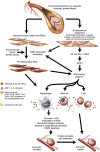Biology of intracranial aneurysms: role of inflammation
- PMID: 22781330
- PMCID: PMC3434628
- DOI: 10.1038/jcbfm.2012.84
Biology of intracranial aneurysms: role of inflammation
Abstract
Intracranial aneurysms (IAs) linger as a potentially devastating clinical problem. Despite intense investigation, our understanding of the mechanisms leading to aneurysm development, progression and rupture remain incompletely defined. An accumulating body of evidence implicates inflammation as a critical contributor to aneurysm pathogenesis. Intracranial aneurysm formation and progression appear to result from endothelial dysfunction, a mounting inflammatory response, and vascular smooth muscle cell phenotypic modulation producing a pro-inflammatory phenotype. A later final common pathway appears to involve apoptosis of cellular constituents of the vessel wall. These changes result in degradation of the integrity of the vascular wall leading to aneurysmal dilation, progression and eventual rupture in certain aneurysms. Various aspects of the inflammatory response have been investigated as contributors to IA pathogenesis including leukocytes, complement, immunoglobulins, cytokines, and other humoral mediators. Furthermore, gene expression profiling of IA compared with control arteries has prominently featured differential expression of genes involved with immune response/inflammation. Preliminary data suggest that therapies targeting the inflammatory response may have efficacy in the future treatment of IA. Further investigation, however, is necessary to elucidate the precise role of inflammation in IA pathogenesis, which can be exploited to improve the prognosis of patients harboring IA.
Figures


References
-
- Ait-Oufella H, Taleb S, Mallat Z, Tedgui A. Recent advances on the role of cytokines in atherosclerosis. Arterioscler Thromb Vasc Biol. 2011;31:969–979. - PubMed
-
- Andersson J, Libby P, Hansson GK. Adaptive immunity and atherosclerosis. Clin Immunol. 2010;134:33–46. - PubMed
-
- Anto RJ, Mukhopadhyay A, Shishodia S, Gairola CG, Aggarwal BB. Cigarette smoke condensate activates nuclear transcription factor-kappaB through phosphorylation and degradation of IkappaB(alpha): correlation with induction of cyclooxygenase-2. Carcinogenesis. 2002;23:1511–1518. - PubMed
-
- Aoki T, Kataoka H, Ishibashi R, Nakagami H, Nozaki K, Morishita R, Hashimoto N.2009aPitavastatin suppresses formation and progression of cerebral aneurysms through inhibition of the nuclear factor kappaB pathway Neurosurgery 64357–365.discussion 365–6 - PubMed
Publication types
MeSH terms
Substances
Grants and funding
LinkOut - more resources
Full Text Sources
Other Literature Sources
Medical

